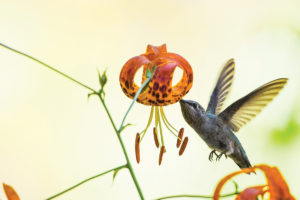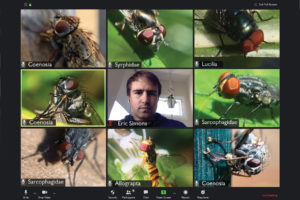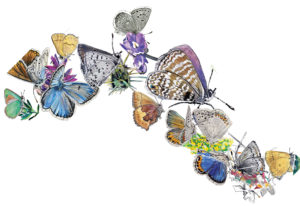The first time I began to pay closer attention to the small band of Columbian blacktail deer that coexist—more or less peacefully—with my neighborhood’s human residents was during the summer of 1997 while working outside on my house in Belmont on the San Francisco Peninsula. Here, as in many other Bay Area neighborhoods, human habitation and traditional oak woodland deer habitat overlap. That hot afternoon the strong odor of decay forced me to place an urgent call to Animal Control Services to request removal of the body of an old buck from under the deck of the vacant house next door. Soon thereafter the huge 200-pound Columbian blacktail buck I call Brutus appeared on the scene to stake his claim to an area that included the orchard and streambed on the other side of my back fence. Within a few days, he had established his day bed in a dense stand of bamboo. Later on, when a herniated disk reduced me from mountain trail runner to sedentary stay-at-home, the enforced lethargy gave me the opportunity to closely observe the comings and goings of Brutus’ band, including the old doe matriarch, whom I dubbed Agrippina, with her extended family of fawns and daughter deer and some of the other bucks in the bachelor herd. As I observed my local band interacting—rearing their young, asserting dominance, and building social hierarchies—two questions kept recurring: How is it that a large, social mammal like the blacktail deer can exist, even thrive, in a densely populated metropolis of some seven million human residents? And what was it about their biology and social habits that allows blacktails to so successfully meet their habitat requirements in an environment subdivided and built over by people?
As part of my physical therapy I began taking evening hikes at Edgewood Park and Natural Preserve in Redwood City, where I was able to study at close range another blacktail herd with a dominant three-point buck in a less urban setting (albeit in the shadow of I-280). This herd, I discovered, had the same essential family structures and behavior patterns as their suburban cousins, which are also nonmigratory, “landmark aware,” small herd animals. However, my backyard deer have managed to compress and superimpose the functional elements of their society over my neighborhood, which is, after all, typical deer habitat interspaced with sections of asphalt and concrete. They used my orchard as a fawning zone and an abandoned garden next door as a nursery, and they linked a higher sleeping area to a feeding zone downstream via a deer path, all similar to the functional arrangement of space I observed them using on the rolling hillside above the picnic area at Edgewood. By comparing these two herds, and also observing blacktail behavior at Huddart Park in Woodside, at Big Basin State Park in the Santa Cruz Mountains, and in the black oak woodland at Castle Rock State Park above Saratoga, I came to the realization that Columbian blacktails are already perfectly suited, socially and biologically, to live among us.
Columbian Blacktail Deer
Columbian blacktail deer (Odocoileus hemionus columbianus) are the subspecies of blacktails native to the Bay Area and normally inhabit a 100-mile-wide band of woodlands and chaparral-covered coastal mountains extending inland from the Pacific Ocean, from the Queen Charlotte Islands in British Columbia south to Santa Barbara in Southern California. A second blacktail subspecies, the stockier and shorter-faced Sitka (Odocoileus hemionus sitkensis), lives farther north in the rain forests of southeast Alaska and north-coastal British Columbia. According to the California Department of Fish and Game (DFG), there are now approximately 560,000 deer in all California, about 320,000 of which are Columbian blacktails; the rest are various subspecies of mule deer. Of course, we have no data on original deer populations, but on his 18th century expedition to colonize California, Juan Bautista de Anza (1736-1783) did note how blacktails were quite abundant around San Francisco Bay. Blacktails have a typical life span in the wild of seven to ten years, but they can thrive in suburban habitat for as long as 17 to 20 years if unmolested.
Not surprisingly, deer, elk, and antelope populations plunged after the Gold Rush and the era of commercial hunting for venison and rawhide production that followed. DFG has records showing that one firm in Redding shipped 35,000 deer hides in 1880! A series of hard winters around the turn of the last century further reduced their numbers; DFG speculates that between 1900 and 1910 there were fewer than 300,000 deer of all types in California. From this nadir, they staged a dramatic comeback until by the late 1940s the population shot up to over a million, far outstripping the carrying capacity of available habitat. This was partly due to the regulation of hunting beginning in 1907, and to extensive logging, slash fires and brush clearance by settlers that drastically altered the landscape, creating more prime deer forage. From that high point 60 years ago, deer populations declined, as a result of habitat loss through fire suppression and the loss of wildlands to agricultural and suburban development.
However, today many small herds of blacktails, like the one in my backyard, seem to have successfully reclaimed some of their lost range in Bay Area suburbs, where, according to UC Berkeley Professor Dale R. McCullough, the deer population is actually three to four times more dense than in the adjacent open spaces. McCullough theorizes that nutritional factors are the cause: The gardens in the suburbs are better tended and fertilized than wild plants in nearby public open spaces. These suburbanized deer are, as a consequence, much bigger, but also, like their human counterparts, fatter, softer, and more injury-prone. They are also about two weeks ahead of wildland herds in their annual cycle of growth, rutting, and birth, something I confirmed when I compared the dates of fawns born in my backyard in mid-May to those born two to four weeks later in the semi-wilds of Edgewood.
Basic Blacktail Sociology
A common misconception is that blacktails have wandered from open space into our neighborhoods across an ever-proliferating grid of freeways and strip malls. This is certainly true for bucks that range out over a large area between September and December, often at their mortal peril, chasing estrogenic does across freeways and busy intersections. Also, when forage is scarce in the adjacent open spaces during the dry season, nonresident wild deer may “commute” into the suburbs for more nutritious feed, says McCullough.
However, unlike mule deer, which engage in seasonal migrations as long as a hundred miles, suburban and wild blacktails alike are essentially small herd animals that cooperatively establish core territories bounded by recognized landmarks, which they then vigorously defend against intruding alien deer. This ensures a relatively stable food supply for the resident band. A dominant buck will always return to his core area in the spring unless he is killed or his habitat is radically altered. The same holds true for does, who will generally spend their whole lives in one core territory. However, as McCullough points out, suburban deer have minuscule home ranges, measuring three or four blocks for females, whereas wild deer inhabit territories that extend for several miles. Their ability to miniaturize their social structures apparently allows blacktails to take advantage of suburban microhabitats in the Bay Area, at least where there is sufficient water, cover, and nutritious forage.
The family herd forms the constant building block of blacktail society and consists of a group leader, or alpha doe, and her relatives, typically a sister or daughter deer and last year’s fawns. The alpha doe picks out the most favorable fawning area and breeds and fawns first. Each fawning season in my neighborhood, the doe matriarch Agrippina and her family herd have used the abandoned garden adjacent to my orchard as a nursery. Why? With an intermittent stream that originates, ironically enough, from the overflow of a storm drain, the garden is essentially a riparian corridor containing what Washington State University Cooperative Extension considers a perfect woodland fawning zone for blacktails: a ratio of 50 percent hiding to 50 percent thermal cover. The flat bottomland also matches the Extension’s criteria: low shrubs from two to six feet tall for concealment and a tree overstory of approximately 50 percent crown closure for thermal cover. There is also a plentiful supply of natural forage nearby in the form of clover and raspberry-blackberry hybrids. As a consequence, I have had the privilege of witnessing the births of several fawns over my back fence.
The bachelor herd forms the other main building block of blacktail society. Although this herd exists as a physical entity only for a short time in early summer, the place a buck defines for himself in its hierarchy determines mating rights later on that fall. When a buck reaches maturity at around 16 to 18 months, the alpha doe drives the young “spike” out of her family group. Last year I observed a young buck who sat day after day under my neighbor’s apple tree, rebuffed whenever he attempted to rejoin his mother and sisters. Such a youngster must soon define his place in the male hierarchy by sparring with rival bucks. This process appears to be ritualized with no observable animosity between the two combatants. I once watched this same young buck walk up to Brutus, extend his right hoof, bow three times, then walk a short distance away and wait. Brutus got up, shook the straw off his back, and went off with the buck to spar. The dominant buck appears to function as a role model for the younger males, instructing them in the art of combat.
Last summer I was surprised to see Agrippina included in the bachelor herd that congregates each day in a semicircle under the Jacuzzi next door. Such gender tolerance is apparently a social trait that allows blacktails to adapt successfully to the close quarters of their adopted suburban microhabitats, where it is impossible to create the physical separation between male and female groupings that would occur in wildlands.
A New Cervid Family Tree
Until quite recently, the majority of wildlife biologists classified Columbian blacktails as a subspecies of mule deer (Odocoileus hemionus hemionus). Even the National Audubon Society in its authoritative Field Guide to North American Mammals (1996) listed Columbian blacktails as mule deer. True, like mule deer, Columbian blacktails have very large ears that rotate independently to listen for danger in all directions, but there the obvious similarities end. In Mule Deer Country (1999), Professor Valerius Geist of the University of Calgary explains how recent genetic analysis seems to confirm what the Lewis and Clark expedition reported back to Thomas Jefferson on first encountering them in Washington State in 1805: Blacktails are a distinct species. According to Geist, our local deer are actually the result of more than 10 million years of cervid evolutionary development. This reevaluation is extraordinary when you consider that blacktails have been among the most studied wildlife species in California, with data for some herds dating back to the early 20th century.
All three major deer species native to North America (blacktail, whitetail, and mule) trace their ancestry back to a primordial, rabbit-size Odocoileus, which had fangs and no antlers and lived around the Arctic Circle some 10 million years ago. After testing the mitochondrial DNA (DNA on the maternal side) of all three species, researchers theorized that whitetails (Odocoileus virginianus) emerged as a separate species on the East Coast about 3.5 million years ago. They apparently expanded their range down the East Coast and then westward across the continent until reaching the Pacific Ocean in what is now California, some 1.5 million years ago. Moving north up the coast, they evolved into blacktails. Then, a very interesting process of crossbreeding and hybridization began to take place, fusing social behavior with genetics.
Near the end of the Pleistocene, some 11,000 years ago, as the glacial ice receded from the Sierra passes, blacktails moving east from their traditional homes in the coastal valleys of California, Oregon, Washington, and British Columbia began to encounter a second wave of whitetails expanding their range westward across the Great Plains. It is now believed that subsequent back-and-forth crossbreeding resulted in the various strains of mule deer scattered across California and the western United States that are now considered examples of species-in-the-making, none over 11,000 years old.
The Emerging Suburban Deer Habitat
Some of the same factors that led to the resurgence of deer populations in California after 1910 are also operative in the Bay Area suburbs today. Just as logging and brush clearance provided more young shrubs for forage, so suburban development has created a nutritionally rich, if cramped, deer habitat, which the local Columbian blacktails have strategically adapted their small herd behavior patterns to exploit. When I cleared the impenetrable bramble of thornbushes out of the valley bottom over my back fence to plant an orchard, I inadvertently opened up a miniature boundary zone environment where blacktails could browse on a newly exposed and expanded margin of blackberry-raspberry hybrids. Within a week, I counted 20 deer in the clearing at one time, whereas before only a couple had ambled through each day. My suburban hillside backyard seems to be representative of other low-density neighborhoods, such as San Carlos, Danville, or Mill Valley, that border open spaces.
So are there more deer now in our residential neighborhoods? There certainly is a common perception, backed by anecdotal sightings of deer ambling down suburban streets in broad daylight, that deer populations in the suburbs are mushrooming. The recent sightings of mountain lions in Palo Alto and other urban/suburban communities around the Bay Area heighten the impression that deer are moving into residential neighborhoods and bringing the big cats with them. However, according to local experts such as Deborah Bartens, naturalist for the City of Palo Alto, there is no hard evidence that more deer are moving into the suburbs. She has noticed no increase in the number of deer in the city’s adjacent open space preserves, and the largest suburban deer populations are still concentrated in the higher perimeter of suburbs, like mine, nearest the foothills.
According to Craig Stowers, senior wildlife biologist at DFG, there are currently “no valid protocols in place for [determining] the relationship of population densities between suburban and wild deer.” When Professor McCullough and his graduate students did a survey in the 1990s to compare the populations of suburban deer in El Cerrito and Kensington to feral deer farther up the hill in Wildcat Canyon and Tilden Regional Parks, they estimated a peak population of about 375 deer in those residential communities in 1995. Due to undetermined factors such as weather, nutrition, and fawn mortality, McCullough believes that the suburban deer population in that same area is now down to about a quarter of that peak figure. However, because the numbers of wild and suburban deer fluctuate around the Bay in a broad synchrony, but with considerable local variation, McCullough can’t say whether this drop represents a long-term trend or the low point of a cyclical pattern. For instance, in Monterey, where deer have lived in town for a long time, observations suggest that population size changes on a cycle of about 15 years. So McCullough cautions against extrapolating results from one or two local studies to draw conclusions on how suburban deer are doing across the entire Bay Area.
If there actually are fewer suburban deer on the Peninsula than there were 10 years ago, they still appear quite numerous in places like my backyard, or my neighbor’s vegetable garden, where water, cover, and, above all, highly nutritious forage coincide to create an ideal habitat. In such places, the same adaptive strategies blacktails employ in the wild have allowed them to successfully convert human space for their own uses while we go about our daily business largely oblivious to their presence, except when they dart out into the path of our cars, devour our prize roses, or, as in my own case, when injury or illness forces us to slow down and pay closer attention to the megafauna in our own backyards.

.jpg)



